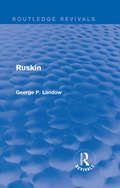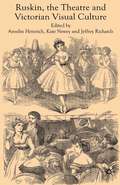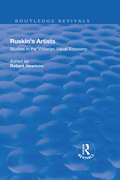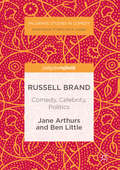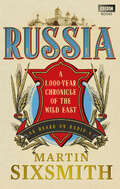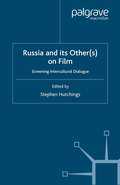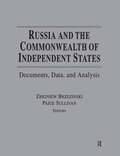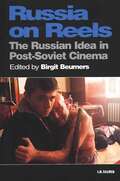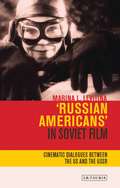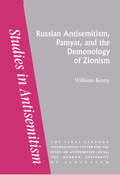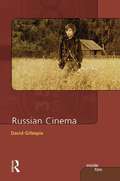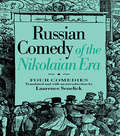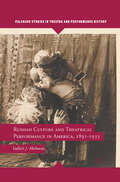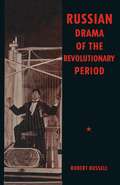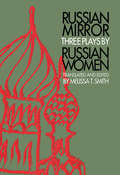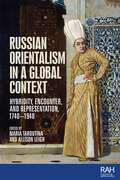- Table View
- List View
Ruskin: Carlyle, Ruskin, Arnold, Morris (Routledge Revivals)
by George P. LandowRuskin, the great Victorian critics of art and society, had an enormous influence on his age and our own. A highly successful propagandist for the arts, he did much both to popularize high art and to bring it to the masses. A brilliant theorist and practical critics of realism, he also produced the finest nineteenth-century discussions of fantasy, the grotesque, and pictorial symbolism. Most who have written about this outstanding Victorian polymath have approached him either as literary critics or as art historians. In this book, which was first published in 1985, George P. Landow provides a more balanced view and offers a strikingly new approach which reveals that Ruskin wrote throughout his career as an interpreter, an exegete. His interpretations covered many fields of human experience and endeavour, not only paintings, poems, and buildings but also contemporary social issues, such as the discontent of the working classes.
Ruskin (Routledge Revivals)
by George P. LandowRuskin, the great Victorian critics of art and society, had an enormous influence on his age and our own. A highly successful propagandist for the arts, he did much both to popularize high art and to bring it to the masses. A brilliant theorist and practical critics of realism, he also produced the finest nineteenth-century discussions of fantasy, the grotesque, and pictorial symbolism. Most who have written about this outstanding Victorian polymath have approached him either as literary critics or as art historians. In this book, which was first published in 1985, George P. Landow provides a more balanced view and offers a strikingly new approach which reveals that Ruskin wrote throughout his career as an interpreter, an exegete. His interpretations covered many fields of human experience and endeavour, not only paintings, poems, and buildings but also contemporary social issues, such as the discontent of the working classes.
Ruskin, the Theatre and Victorian Visual Culture
by A. Heinrich K. Newey J. RichardsThis collection of essays sets out to challenge the dominant narrative about Victorian theatre by placing the practices and products of the Victorian theatre in relation to Victorian visual culture, through the lens of the concept of 'Ruskinian theatre', an approach to theatre which values its educative purpose as well as its aesthetic expression.
Ruskin's Artists: Studies in the Victorian Visual Economy (Routledge Revivals)
by Robert HewisonThis was first published in 2000: A study of John Ruskin's engagement with art and architecture as a critic, a patron and a teacher. It offers insights into both his writings and the visual economy of the Victorian world. Each essay examines Ruskin's relationship with an individual artist or a distinct aspect of art practice. J.M.W. Turner, D.G. Rossetti, W. Holman Hunt and E. Burne-Jones are among those artists discussed whose personal relationships with Ruskin affected his critical writing. Ruskin's attitude to women artists and his approach to the teaching of art are given special attention.
Ruskin's Artists: Studies in the Victorian Visual Economy (Routledge Revivals)
by Robert HewisonThis was first published in 2000: A study of John Ruskin's engagement with art and architecture as a critic, a patron and a teacher. It offers insights into both his writings and the visual economy of the Victorian world. Each essay examines Ruskin's relationship with an individual artist or a distinct aspect of art practice. J.M.W. Turner, D.G. Rossetti, W. Holman Hunt and E. Burne-Jones are among those artists discussed whose personal relationships with Ruskin affected his critical writing. Ruskin's attitude to women artists and his approach to the teaching of art are given special attention.
Russell Brand: Comedy, Celebrity, Politics (Palgrave Studies in Comedy)
by Jane Arthurs Ben LittleRussell Brand is one of the most high profile and controversial celebrities of our time. A divisive figure, his ability to bounce back from adversity is remarkable. This book traces his various career stages through which he has done this, moving from comedy, to TV presenting; from radio to Hollywood films. It identifies how this eclectic career in entertainment both helped and hindered his high-profile move into political activism. Underpinning the book are interviews with leading activists and politicians, and sophisticated readings of Brand's performances, writing and on-screen work. There are sections on the Sachsgate scandal, his Newsnight interview with Jeremy Paxman, and his 2015 election intervention for aspiring Prime Minister Ed Miliband. It builds on scholarly work in the area of celebrity politics to develop an original analytic approach that blends the field theory of Pierre Bourdieu with the assemblage theory of Gilles Deleuze and Felix Guattari.
Russia: A 1,000-Year Chronicle of the Wild East
by Martin SixsmithRussia is a country of contradictions: a nation of cultural refinement and artistic originality and yet also a country that rules by 'the iron fist'. In this riveting history, Martin Sixsmith shows how Russia's complex identity has been formed over a thousand years, and how it can help us understand its often baffling behaviour at home and abroad.Combining in-depth research and interviews with his personal experiences as a former BBC Moscow correspondent, Sixsmith skilfully traces the conundrums of modern Russia to their roots in its troubled past, and explains the nation's seemingly split personality as the result of influences that have divided it for centuries.A Sunday Times bestseller, Russia is essential reading for anyone who wants to understand the complex political landscape of this country, and its unique place in the modern world.
Russia and its Other: Screening Intercultural Dialogue (Studies in Central and Eastern Europe)
by S. HutchingsRussia's interactions with the West have been a perennial theme of Slavic Studies, and of Russian culture and politics. Likewise, representations of Russia have shaped the identities of many western cultures. No longer providing the 'Evil Empire' of 20th American popular consciousness, images of Russia have more recently bifurcated along two streams: that of the impoverished refugee and that of the sinister mafia gang. Focusing on film as an engine of intercultural communication, this is the first book to explore mutual perceptions of the foreign Other in the cinema of Russia and the West during, and after, communism. The book's structure reflects both sides of this fascinating dialogue: Part 1 covers Russian/Soviet cinematic representations of otherness, and Part 2 treats western representations of Russia and the Soviet Union. An extensive Introduction sets the dialogue in a theoretical context. The contributors include leading film scholars from the USA, Europe and Russia.
Russia and the Commonwealth of Independent States: Documents, Data, and Analysis
by Zbigniew K BrzezinskiThis work brings together major accords and protocols that form the institutional framework of the Commonwealth of Independent States (CIS); a selection of policy statements by the leaders of CIS countries; a chronological record of political, economic and military security developments and major crises in CIS "hot spots"; and statistics and country profiles.
Russia and the Commonwealth of Independent States: Documents, Data, and Analysis
by Zbigniew K BrzezinskiThis work brings together major accords and protocols that form the institutional framework of the Commonwealth of Independent States (CIS); a selection of policy statements by the leaders of CIS countries; a chronological record of political, economic and military security developments and major crises in CIS "hot spots"; and statistics and country profiles.
Russia on Reels: The Russian Idea in Post-Soviet Cinema (KINO - The Russian and Soviet Cinema)
by Birgit BeumersThis is the first book to deal exclusively with Russian cinema of the 1990s. It introduces readers to the currents and common interests of contemporary Russian cinema, offers close studies of the work of filmmakers like Sokurov, Muratova and Astrakhan, reviews the Russian film industry in a period of massive economic transformation, and assesses cinema's function as a definer of Russia's new identity.
Russia on Reels: The Russian Idea in Post-Soviet Cinema (KINO - The Russian and Soviet Cinema)
by Birgit BeumersThis is the first book to deal exclusively with Russian cinema of the 1990s. It introduces readers to the currents and common interests of contemporary Russian cinema, offers close studies of the work of filmmakers like Sokurov, Muratova and Astrakhan, reviews the Russian film industry in a period of massive economic transformation, and assesses cinema's function as a definer of Russia's new identity.
Russian Americans' in Soviet Film: Cinematic Dialogues Between the US and the USSR (KINO - The Russian and Soviet Cinema)
by Marina L. LevitinaCertain aspects of American culture had a formative influence on early Soviet identity and aspirations. Popular films and translated adventure fiction from the United States were warmly received in 1920s Russia and partly shaped ideals of the New Soviet Man and Woman into the 1940s. Cinema was crucial to propagating this new social hero. In Soviet Socialist Realist films, certain positive heroes and heroines are noticeably similar to the American stars Douglas Fairbanks, Pearl White and Mary Pickford. Other films represent the contemporary Stalinist trope of the 'Russian American' – an ideal worker exemplifying revolutionary zeal and American efficiency. Surveying over 60 Soviet and American films, and bringing new archival research to light, the book explores fresh territory in Soviet cinema and Soviet-American relations.
Russian Antisemitism Pamyat/De (Studies In Antisemitism Ser. #Vol. 2.)
by CoreyFirst Published in 1995. Routledge is an imprint of Taylor & Francis, an informa company.
Russian Antisemitism Pamyat/De
by CoreyFirst Published in 1995. Routledge is an imprint of Taylor & Francis, an informa company.
Russian Cinema
by David C. GillespieRussian Cinema provides a lively and informative exploration of the film genres that developed during Russia's tumultuous history, with discussion of the work of Eisenstein, Pudovkin, Mikhalkov, Paradzhanov, Sokurov and others. The background section assesses the contribution of visual art and music, especially the work of the composers Shostakovich and Prokofev, to Russian cinema. Subsequent chapters explore a variety of topics: The literary space - the cinematic rendering of the literary text, from 'Sovietized' versions to bolder and more innovative interpretations, as well as adaptations of foreign classics The Russian film comedy looks at this perennially popular genre over the decades, from the 'domestication' of laughter under Stalin to the emergence of satire The historical film - how history has been used in film to affirm prevailing ideological norms, from October to Taurus Women and Russian film discusses some of the female stars of the Soviet screen (Liubov Orlova, Vera Alentova, Liudmila Gurchenko), as well as films made by male and female directors, such as Askoldov and Kira Muratova Film and ideology shows why ideology was an essential component of Soviet films such as The Maxim Trilogy, and how it was later definitively rejected The Russian war film looks at Civil War and Second World War films, and the post-Soviet treatment of recent conflicts in Afghanistan and Chechnya Private life and public morality explores the evolution of melodramas about youth angst, town and village life, personal relationships, and the emergence of the dominant sub-genre of the 1990s, the gangster thriller Autobiography, memory and identity offers a close reading of the work of Andrei Tarkovskii, Russia's greatest post-war director, whose films, including Andrei Rublev and Mirror, place him among the foremost European auteur film-makers Russian Cinema offers a close analysis of over 300 films illustrated with representative stills throughout. As with other titles in the Inside Film series it includes comprehensive filmographies, a thorough bibliography and an annotated further reading list. The book is a jargon-free, accessible study that will be of interest to undergraduates of film studies, modern languages, Russian language and literature, as well as cineastes, film teachers and researchers.
Russian Cinema
by David C. GillespieRussian Cinema provides a lively and informative exploration of the film genres that developed during Russia's tumultuous history, with discussion of the work of Eisenstein, Pudovkin, Mikhalkov, Paradzhanov, Sokurov and others. The background section assesses the contribution of visual art and music, especially the work of the composers Shostakovich and Prokofev, to Russian cinema. Subsequent chapters explore a variety of topics: The literary space - the cinematic rendering of the literary text, from 'Sovietized' versions to bolder and more innovative interpretations, as well as adaptations of foreign classics The Russian film comedy looks at this perennially popular genre over the decades, from the 'domestication' of laughter under Stalin to the emergence of satire The historical film - how history has been used in film to affirm prevailing ideological norms, from October to Taurus Women and Russian film discusses some of the female stars of the Soviet screen (Liubov Orlova, Vera Alentova, Liudmila Gurchenko), as well as films made by male and female directors, such as Askoldov and Kira Muratova Film and ideology shows why ideology was an essential component of Soviet films such as The Maxim Trilogy, and how it was later definitively rejected The Russian war film looks at Civil War and Second World War films, and the post-Soviet treatment of recent conflicts in Afghanistan and Chechnya Private life and public morality explores the evolution of melodramas about youth angst, town and village life, personal relationships, and the emergence of the dominant sub-genre of the 1990s, the gangster thriller Autobiography, memory and identity offers a close reading of the work of Andrei Tarkovskii, Russia's greatest post-war director, whose films, including Andrei Rublev and Mirror, place him among the foremost European auteur film-makers Russian Cinema offers a close analysis of over 300 films illustrated with representative stills throughout. As with other titles in the Inside Film series it includes comprehensive filmographies, a thorough bibliography and an annotated further reading list. The book is a jargon-free, accessible study that will be of interest to undergraduates of film studies, modern languages, Russian language and literature, as well as cineastes, film teachers and researchers.
Russian Comedy of the Nikolaian Rea (Russian Theatre Archive Ser.)
by Laurence SenelickThese four Russian comedies were written during the reign of Nicholas I, a period of considerable repression and censorship. They represent the most popular genres of the period. Lensky's Her First Night was an immensely popular vaudeville which held the stage for years; Kozma Prutkov's Fantasy is a parody of vaudeville which was banned after one night. Turgenev's Luncheon with the Marshal is a comedy of manners about provincial life, and Saltykov-Schedrin's Pazukhin's Death is a satire of greed and corruption so savage that it was forbidden during the author's lifetime. This collection constitutes a remarkable comic spectrum which will assist in enlarging the English language repertoire with a set of newly available and hightly stageworthy scripts.
Russian Comedy of the Nikolaian Rea
by Laurence SenelickThese four Russian comedies were written during the reign of Nicholas I, a period of considerable repression and censorship. They represent the most popular genres of the period. Lensky's Her First Night was an immensely popular vaudeville which held the stage for years; Kozma Prutkov's Fantasy is a parody of vaudeville which was banned after one night. Turgenev's Luncheon with the Marshal is a comedy of manners about provincial life, and Saltykov-Schedrin's Pazukhin's Death is a satire of greed and corruption so savage that it was forbidden during the author's lifetime. This collection constitutes a remarkable comic spectrum which will assist in enlarging the English language repertoire with a set of newly available and hightly stageworthy scripts.
Russian Culture and Theatrical Performance in America, 1891-1933 (Palgrave Studies in Theatre and Performance History)
by V. HohmanExamining the work of impresarios, financiers, and the press as well as the artists themselves, Hohman demonstrates how a variety of Russian theatrical styles were introduced and incorporated into American theatre and dance during the beginning of the twentieth century.
Russian Drama of the Revolutionary Period
by Robert RussellThe period between the Revolution of 1917 and Stalin's coming to power in the early 1930s was one of the most exciting for all branches of the arts in Russia. This study tries to show how the diversity of the Soviet arts of the 1920s continued the major trends of the pre-Revolutionary years.
Russian Mirror: Three Plays by Russian Women (Russian Theatre Archive Ser. #Vol. 14.)
by Melissa T. SmithThe three playwrights presented together in this volume On the Road to Ourselves), Elena Gremina (Behind the Mirror) and Olga Mikhailova (Russian Dream). The selected plays contain many elements which will appeal to Western directors and audiences: well-drawn characters, engaging plots, lively wit. Central to the three plays selected in this volume is a complex interaction of Russian and Western value systems, a theme that becomes increasingly relevant for Russian audiences with each passing season and no less relevant for Europeans and Americans.
Russian Mirror: Three Plays by Russian Women
by Melissa T. SmithThe three playwrights presented together in this volume On the Road to Ourselves), Elena Gremina (Behind the Mirror) and Olga Mikhailova (Russian Dream). The selected plays contain many elements which will appeal to Western directors and audiences: well-drawn characters, engaging plots, lively wit. Central to the three plays selected in this volume is a complex interaction of Russian and Western value systems, a theme that becomes increasingly relevant for Russian audiences with each passing season and no less relevant for Europeans and Americans.
Russian Orientalism in a global context: Hybridity, encounter, and representation, 1740–1940 (Rethinking Art's Histories)
by Maria Taroutina and Allison LeighThis volume features new research on Russia’s historic relationship with Asia and the ways it was mediated and represented in the fine, decorative and performing arts and architecture from the mid-eighteenth century to the first two decades of Soviet rule. It interrogates how Russia’s perception of its position on the periphery of the west and its simultaneous self-consciousness as a colonial power shaped its artistic, cultural and national identity as a heterogenous, multi-ethnic empire. It also explores the extent to which cultural practitioners participated in the discursive matrices that advanced Russia’s colonial machinery on the one hand and critiqued and challenged it on the other, especially in territories that were themselves on the fault lines between the east and the west.
Russian Orientalism in a global context: Hybridity, encounter, and representation, 1740–1940 (Rethinking Art's Histories)
by Maria Taroutina Allison LeighThis volume features new research on Russia’s historic relationship with Asia and the ways it was mediated and represented in the fine, decorative and performing arts and architecture from the mid-eighteenth century to the first two decades of Soviet rule. It interrogates how Russia’s perception of its position on the periphery of the west and its simultaneous self-consciousness as a colonial power shaped its artistic, cultural and national identity as a heterogenous, multi-ethnic empire. It also explores the extent to which cultural practitioners participated in the discursive matrices that advanced Russia’s colonial machinery on the one hand and critiqued and challenged it on the other, especially in territories that were themselves on the fault lines between the east and the west.
